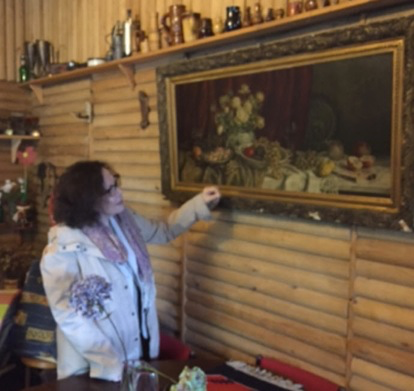STILL LIFE AND OTHER OBJECTS OF MEMORY
Director/Producer: Sławomir Grünberg, Executive Producer Lilka Elbaum
Forty-eight years after being expelled from Poland during the wave of anti-Semitic reprisals against Polish Jews, Lilka Elbaum, a native of Lodz, returns to this city and comes face to face with an object from her past: a still-life painting which hung in her apartment from 1945 to 1968. The destiny of this painting, between the comings and goings of successive tenants of this apartment, is also the destiny of the city, and the painting emerges as a powerful silent witness of community and continuity, of disruption and genocide, of the futility of totalitarian dreams, and, inevitably, of exile and longing.

A history of Jewish Lodz, as seen by the still-life painting

The still life hung in Lilka Elbaum's home in Lodz from 1945 until the family left in 1968. Her parents acquired the painting as part of the apartment's furnishings from a German dentist who had to flee the city after it was liberated in 1945. Little is known of his identity except the fact that he, himself, got the painting and its furnishings from a Jewish family who was forced to leave all of their belongings behind and move into the Litzmannstadt Ghetto. Who the family might have been and what was their fate is traced in the documentary through archival materials relating to the history of the building, its original owners and other tenants.
Lilka's story: Jewish life in post-war Łódź, and the expulsion of 1968

In 1968, a little more than twenty years after the Shoah, in yet another surge of anti-Semitism, the majority of Poland's remaining 30,000 Jews were forced into exile, leaving their lives and most of their possessions behind. Lilka's parents sold the contents of the apartment to a gentile friend of the family. She remembers looking back, as they left, at the empty rooms and bare walls, sadly aware of how unnatural this was, how in the over seventy years since it had been first occupied, this was the very first time the apartment was completely empty. The story of the 1968 expulsion of Polish Jews is not well known outside of Poland. The universal perception, until the transformation in Eastern Europe in 1989, was that Jewish life in Poland was totally extinguished. Lilka's life and the lives of the many thousands who lived there until 1968 needs to be told.A rare look at the pre-war Jewish life in Lodz

The still life is an "object of memory," a reminder of her past life in Lodz, which she was forced to in 1968 together with the majority of Polish Jews. It is also an artifact from pre-Holocaust Lodz's Jewish community and along with other artifacts, buildings, maps, and archival documents, is a confirmation that this world existed and, for the second generation of Holocaust survivors these "objects of memory" are often the only connection to the family they never knew but which they long to learn more about. Lilka Elbaum will narrate STILE-LIFE with the participation of Paul Celler, another second-generation descendant of Polish Jews from Lodz. Paul, who was born in the United States, in this journey he will discover traces and "objects of memory" from his own past, which will connect him with own, lost family.Director/Producer: Sławomir Grünberg
Watch the trailer
STILL-LIFE is a historical essay, which mixes elements of a psychological portrait, exceptionally unique and contemporary language of creative animation combined with cognitive and fact-finding cinema. The story told in this film is universal, and should reach every viewer regardless of the origins or level of education. The cognitive qualities of the film are immense and can be viewed through the prism of historical as well as philosophical, psychological and social lenses. On the one hand, the people interviewed by the director are commenting on the story of the main character, on the other, through archival footage and creatively animated sequences, the viewer gets to learn historical facts forming the backdrop of the story. An exclusive animation technique invented for the "Karski & The Lords of Humanity" movie by the Polish animators from the Badi Badi studio can be seen in the film's trailer. "Karski & The Lords of Humanity" uses animated sequences and reconstructed scenes to illustrate events, which were never actually caught on camera. Combined with the archival footage and the contemporary interviews they significantly enhanced the film's appeal. This feature-length documentary will be shot on location in Lodz, Tel Aviv, Livingston N. J., New York and Boston and will be released in 2018, the 50th year's anniversary of the 1968 expulsion of Poland's Jews.
Sławomir Grünberg is an Emmy Award-winning documentary producer, director and cameraman is a graduate of the Polish Film School in Lodz. Born in Poland, he immigrated to the US in 1981 and has since directed and produced over 45 documentary films including: Don't Cry When I'm Gone, Karski & The Lords of Humanity, Shimon's Returns, Castaways, Santa Rosa, The Peretzniks, Portraits of Emotion, Coming Out in Poland, The Legacy of Jedwabne and Saved by Deportation. Grunberg's film School Prayer: A Community at War, screened on PBS and received an Emmy Award. Grunberg is a recipient of Guggenheim Fellowship, the New York Foundation for the Arts and Soros Justice Media Fellowships. His credits as director of photography include: Legacy (Academy Award nomination for best documentary feature in 2001), and Sister Rose's Passion, which won best short doc at Tribeca Film Festival in 2004 and received an Academy Award nomination for best documentary short in 2005.

Stay connected on Facebook:








